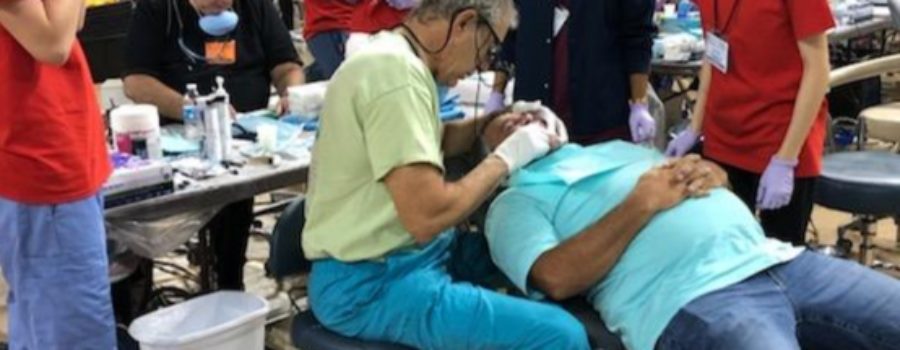This past weekend, I volunteered (with my husband and sister-in-law) at an annual Missions of Mercy event in the Appalachia region of Virginia providing free dental services. An army of dentists, dental students, hygienists, dental assistants, and general volunteers convened in a large college gymnasium to provide these services—along with some array of hope—to hundreds of adults and children who have little or no access to adequate healthcare.
Unemployment is high in this region, and most of the people that attended were either retired, disabled, or out of work. Because they can’t afford dental insurance–and Medicaid in the state only covers emergency extractions–many hadn’t seen a dentist in years. And because they didn’t know when they’d see a dentist again, several attendees at the event preferred to get multiple teeth extracted rather than try to restore them. Upon reviewing their cursory health assessments before seeing a dentist, we were not surprised to see a prevalence of multiple chronic conditions such as diabetes, high blood pressure, and depression. And the opiate epidemic had hit this region hard.
I spoke to some people while they were waiting and found them to be very open and forthcoming about their problems. One woman cried because she had been without any teeth for four years and couldn’t save enough money for a full set of dentures. The need for dentures was overwhelming, and the best we could offer was to put her name on a waitlist for next year.
Another woman, 71 years old, had a long talk with me. She had a college education and had worked as a real estate agent in the community all her life. Now that she was older and no longer employed, she couldn’t afford dental insurance. All she needed was a cleaning, but the line was too long, and she had to be turned away. She also mentioned that she couldn’t afford a hearing aid that was desperately needed.
“We’re the people left behind,” she told me. “We’re the richest country in the world, and yet people in this community are hurting. There aren’t enough doctors here, and I drive about an hour-and-a-half to Johnson City, Tennessee, to see my primary care physician. God forbid if someone has to go to the hospital here with a serious condition. They may not make it out of the hospital alive.” I asked her what she planned to do. Her daughter had recently moved to Charlotte, NC, and she was reluctantly considering moving to Charlotte too so that she could have better access to medical and dental care. She left without any service but thanked me for listening.
Compared with other high-income nations in the world, the United States spends about twice as much on health care per capita, and, according to the Centers for Medicare and Medicaid Services, this will continue to increase. The high cost of prescription drugs in the U.S., compared to other high-income countries, is a big factor. One would think that a higher cost of healthcare would correspond to a higher quality of care, but when compared with other high-income nations, the U.S. has a declining rate of life expectancy and one of the highest infant mortality rates.
In addition, based on data from the last decade, a smaller number of applicants are being admitted to medical school. And fewer medical school graduates are choosing to be primary care physicians, instead pursuing higher-paying specialties. The Association of American Medical Colleges predicts a shortage of between 21,000 and 55,200 primary care physicians in the U.S. by 2032. Rural America has already been hit the hardest by the physician shortage, as a disproportionate number of physicians choose to practice in more urban areas. According to the Association of American Medical Colleges, “Increasing the number of U.S. doctors is necessary, but it will not be sufficient. In the coming years, the nation will need to transform the way health care is delivered, financed, and used.”
While the U.S. public believes our quality of care is the best in the world, for many people it is unaffordable, inaccessible, and too complicated. The solutions are not simple. Do we continue to maintain the wide economic disparity in healthcare that currently exists or try to find a way to provide affordable healthcare to all Americans? As we debate this issue, let’s not forget the urgent needs of the Americans right in our backyard.




